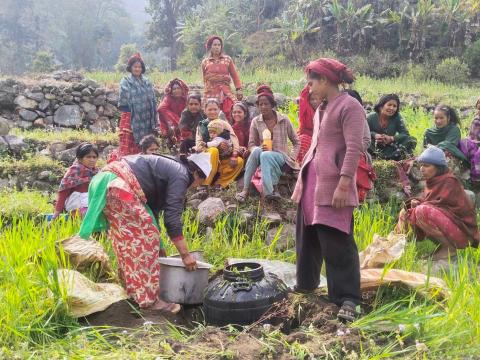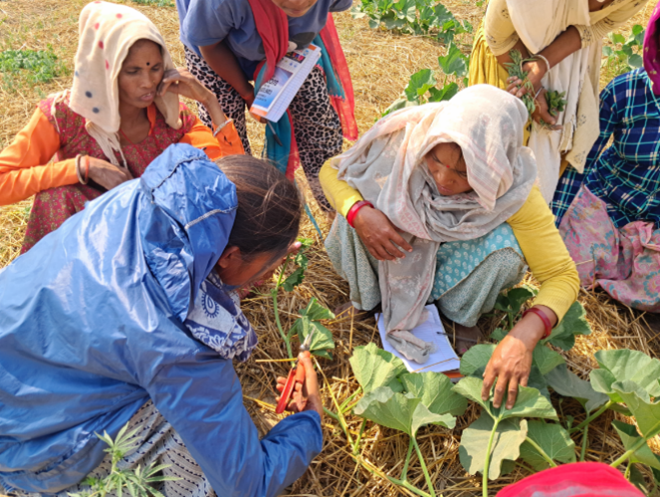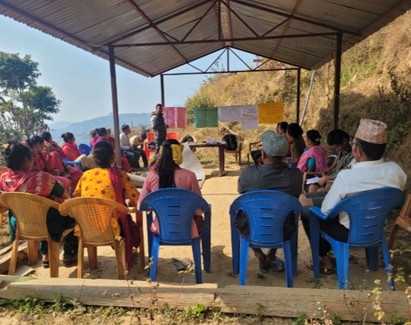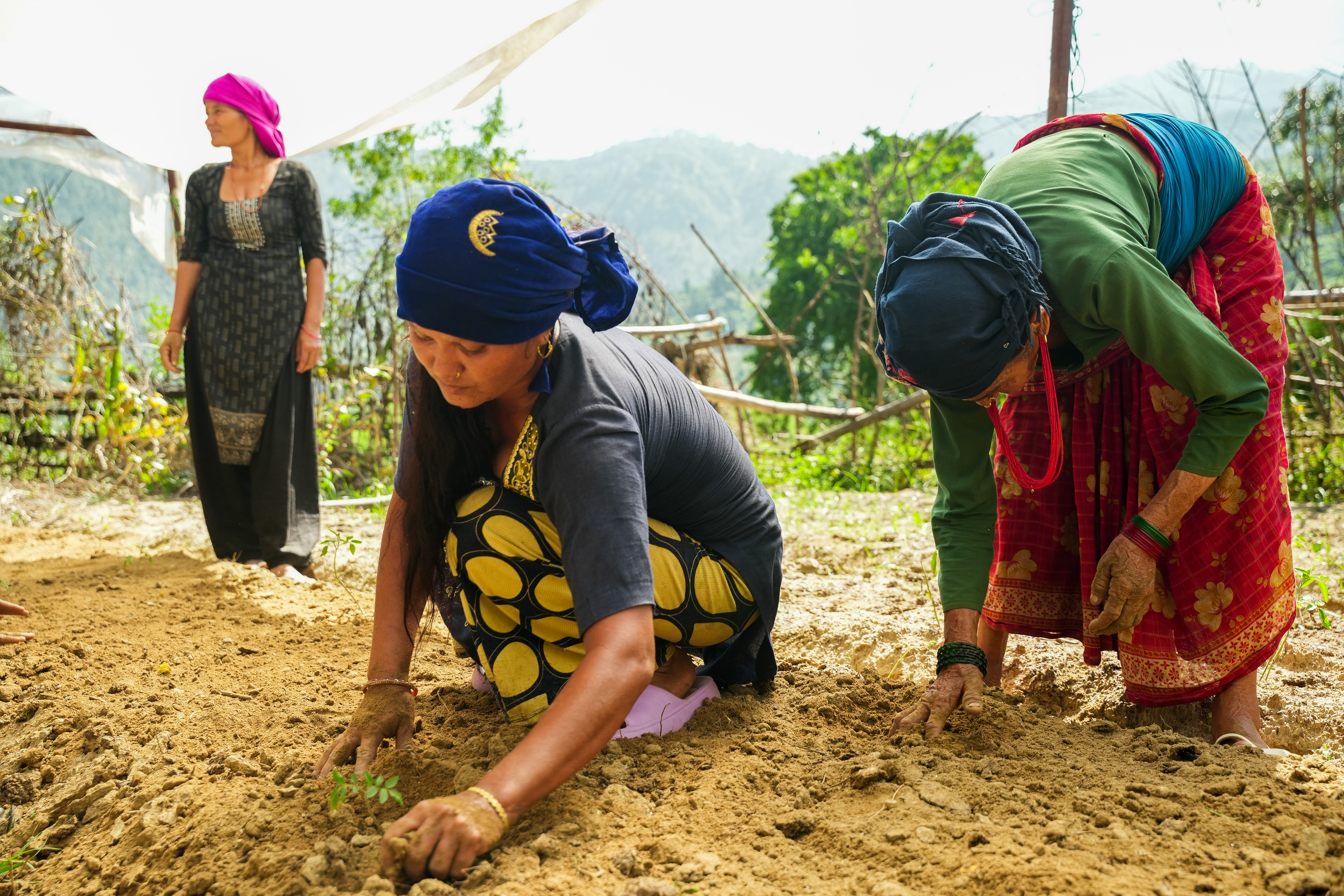Climate Field School: an approach to enable farming communities to learn and use climate-smart practices

Background
Climate change has been a mounting issue across the globe for years. The effects of climate change are significantly evident with increasing temperatures, changes in precipitation patterns, rising sea levels, ocean acidification, shifting agroecosystem boundaries, invasive crops, pest outbreaks and more frequently, extreme weather events. All of these repercussions pose detrimental risks for agriculture production, food and water supplies.[1] Climate change has also been adversely affecting crop yields, damaging the nutritional quality of major cereals, lowering livestock productivity, and exacerbating land degradation processes.[2]
World Vision International (WVI) Nepal is committed to meeting the systemic challenges posed by environmental degradation and climate change for the well-being of children. One of our key strategic areas lie in strengthening field programming to increase sensitivity towards environmental sustainability. As a crucial area of focus, one of the goals of our Livelihood programme is to enhance individuals' resilience and reduce their mitigate to extreme climate events, as well as other economic, social, and environmental challenges and disasters. To achieve this, WVI Nepal has planned to expand actions, initiatives and efforts on climate change adaptation, smart agriculture, low-emission production systems, technologies and green income sources, and effective nature-based solutions. Given that farming households represent a significant section of WVI Nepal’s target demographics, it is essential to back community-driven efforts focused on adapting to climate change, particularly through the promotion of climate-smart agricultural practices.

Farmers Field Schools (FFS) approach was developed by Food and Agriculture Organization - FAO[1] and partners as an alternative to the prevailing top-down extension method in the farming world. In Nepal, this approach was commonly used on Integrated Pest Management (IPM) and is popularly called IPM FFS. Building upon this, there are several effective examples of the implementation of comparable strategies to encourage producers to adopt climate-smart agriculture. A climate-smart approach has been devised by WVI Nepal to empower agricultural families to learn and practise it through Climate Field Schools, based on these learnings.
Issues/Challenges
Agricultural activities take place in 38% of the planet’s terrestrial surface, use approximately 70% of global freshwater resources, and when combined with the distribution and processing of products in the food system, contribute up to one third of human-derived greenhouse gas emissions[2]. With global food demand set to double by 2050[3], there is an increasing debate on how this demand will be achieved at a time when our food systems must contribute towards emission reductions while also adapting to the changing climate.
Nepal has developed pathways for a sustainable food system which envisions the country towards an equitable, resilient, and sustainable food system. The current food system is not functioning well enough to produce the adequate quantities of food to feed and ensure food and nutrition security for the growing population without damaging natural resources and the environment and to benefit everyone equally and equitably under changing climate and economic system.[4]
Objectives
Climate Field Schools (CFS) specifically stress on the options to support farmers, communities and help them identify, implement/monitor and evaluate climate-smart agriculture actions and initiatives. Such actions/initiatives will contribute to the following objectives:
sustainably increasing agricultural productivity and incomes; (Productivity)
adapting and building the resilience of agricultural livelihoods to climate change (Adaptation)
and reducing and/or removing greenhouse gas emissions (Mitigation), where possible.
More specifically, CFS aims to enable female and male farmers:
to acquire knowledge and skills to improve the productivity of their crops/livestock (selected based on their interest and market opportunity).
to refine the farmers’ ability to make critical and informed decisions that render their farming profitable and climate-smart.
to explore new ways of thinking and solve problems linked to climate changes.
to work collectively to decide and act on adaptation to climate change and initiate to organize themselves and their communities, with a focus on women and girls.
Interventions

Basically, CFS has three key stages, which hints at extended period of time to begin with the preparation. The actual learning session is based on the commodity (crop/livestock) and CS technology selected based on identified climatic risks/hazards. Many CFS classes can take up to 22 weeks (about 5 months) if they are designed for a weekly meeting by the farmers.
Stage 1 - Preparation:
Mapping of potential project sites
Agreement with local government and other stakeholders
Developing champions climate change and Disaster Risk Reduction (DRR) actions
Develop context and location-specific CFS plan
Stage 2 - Implementation and Monitoring:
Mapping potential location for piloting
Agreement with respective Community-based Organisations (CBO) and stakeholders
Selection of CS technology in the CFS
Establishment of CFS site
Planning the CFS Learning sessions
Facilitating CFS Monitoring
Evaluation, Learning and Celebration
With the onset of CFS planning (and learning) session, monitoring is the regular collection of information as agreed by participating CBO and farmers. Along with progress tracking on the plan, it will also assure quality of the process and inform required adaptation throughout the CFS learning cycle.
Following the CFS learning session, each CFS will assess variations in yield, input (including labour), and overall cost-benefit analysis. During monitoring, the CFS group will also review the data that has been obtained. Based on these findings, each CFS covers assessing the smartness/benefit of a certain CSA practice/technology in the local context.
Similarly, an evaluation of CFS by participating farmers and the facilitator is organised. A separate test on farmers' knowledge and level of confidence to understand the application of the CSA technology/practice is also completed using the tools developed during CFS planning. Each CFS also prepares a learning report of the CFS with the support of the CFS facilitator.
The assessment and evaluation of the CFS continues throughout the cycle. More precisely, they can be categorised into three key stages.
At the beginning of CFS
Ensure participating farmers’ knowledge test (pre-test)
Discuss and define indicators for monitoring
Record the initial information (considering the CSA practice/technology selected)
Consider planning for soil test to set a baseline for soil carbon in the CFS site
During CFS implementation
Regular record keeping of activities (considering the CSA practice/technology selected)
Weekly feedback/reflection exercises
Engage local stakeholders to visit CFS site for monitoring and feedback as agreed in the beginning of the CFS
Mid-term review of CFS and facilitators performance (PRA tools)
CFS experience shared and discussed with other farmers during field days
At the end of CFS cycle
Analysis of yield, labour input and cost/benefit
Final review of the data gathered through regular monitoring
Discussion and assessment of selected CSA practice/technology
Final farmer knowledge test
Documentation of learning
Planning exercises based on learning
Learning sharing of control plot and CFS plot (Record data for both control plot and CFS plot)
Learning and Update sharing session (cross CFS/combining CFS representative)Celebration workshop at municipal/ward level

Results
In a single year, WVI Nepal has developed and executed 86 CFS that have directly benefited 1,370 agricultural families. This has resulted in the implementation of new knowledge by the producer groups that are participating with greater assurance.
More than 258 producer groups are currently implementing a total of seven climate-smart technologies across various producer groups (livestock and crop). There is currently at least one CSA champion in these organisations who also advocate for collective learning among producers.
There are encouraging results observed by the farmers who have practiced different technologies that include:
lower production cost (production cost has been reduced up to 30%),
less irrigation requirement (up to 25% less water was used),
increase production (reducing loss and increase in yield).
Conclusion
Climate Field School was widely appreciated in the communities and by local stakeholders. This has helped farming communities to improve their farming practices and help small-scale farmers and vulnerable communities adapt to the impact of climate change and be better prepared for future shocks. The children and families increased their knowledge regarding early warning systems, disaster preparedness, hazards, and the impact of climate change on livelihood and agricultural yield. This has further enabled farming communities to explore new ways of thinking and solve problems linked to climate change and take informed decisions that render their farming profitable and climate smart.
Written by: Prakash Tiwari (Associate Director - Technical Programmes and Head - Resilience & Livelihoods) | World Vision International Nepal
[1] https://www.fao.org/agriculture/ippm/programme/ffs-approach/en/
[2] Crippa, M., Solazzo, E., Guizzardi, D., Monforti-Ferrario, F., Tubiello, F.N. & Leip, A. 2021, 'Food systems are responsible for a third of global anthropogenic GHG emissions', Nature Food, vol. 2, no. 3, pp. 198-209.
[3] Fukase, E. & Martin, W. 2020, 'Economic growth, convergence, and world food demand and supply', World Development, vol. 132, p. 104954
[4] Nepal’s Food Systems Transformation: Context, Pathways and Actions, NPC, 2021.